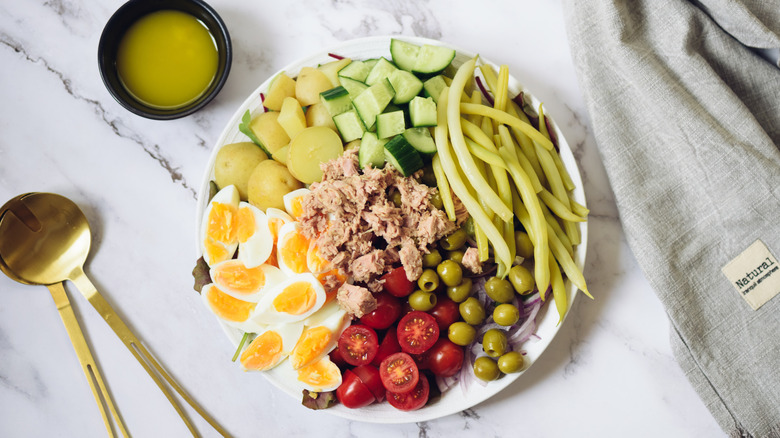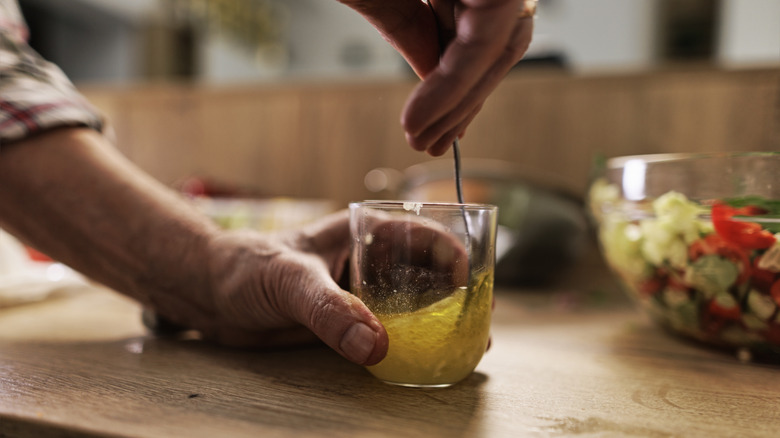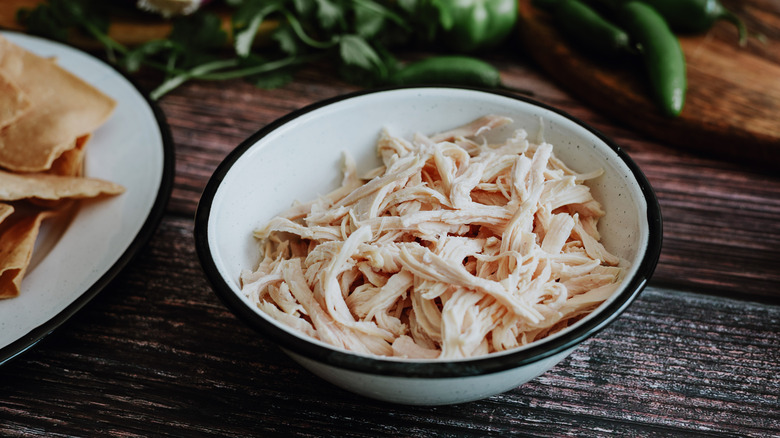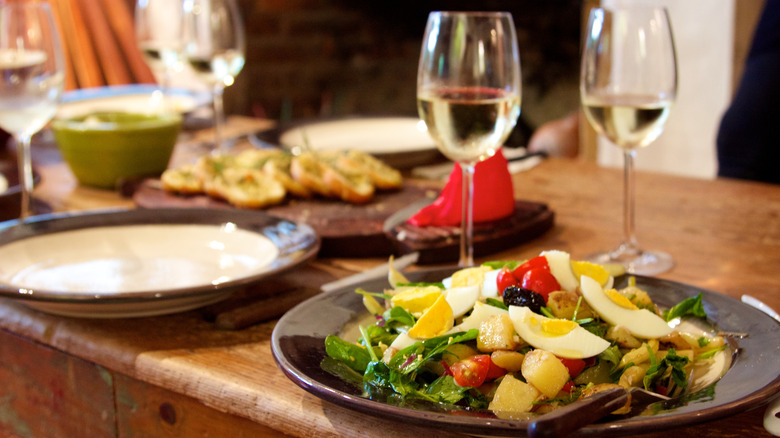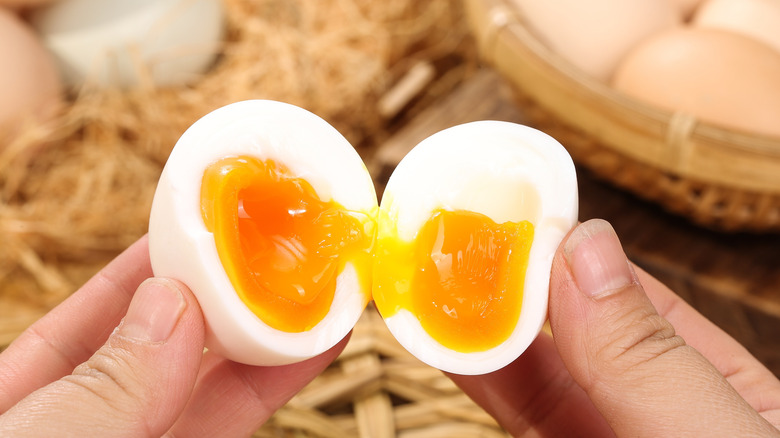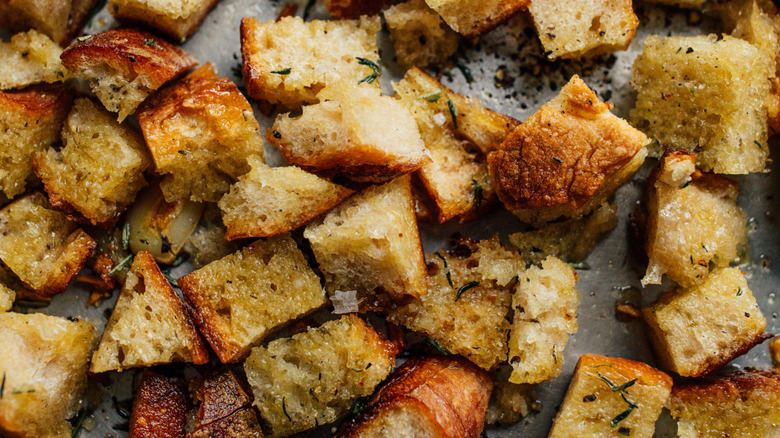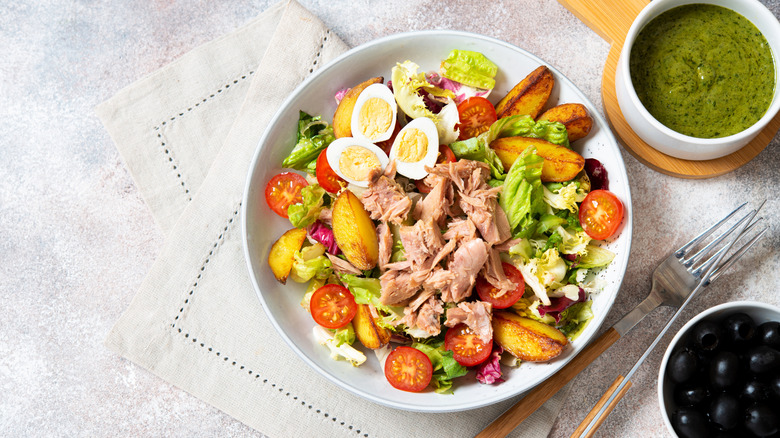How Geoffrey Zakarian Turns Simple Canned Tuna Into A Gourmet Meal
You know chef Geoffrey Zakarian. The long-time Food Network staple, Iron Chef, and restaurateur has been passing judgement on "Chopped" for years and dishing out tips and tricks on "The Kitchen" for hundreds of episodes. He's given us advice on everything from how to make more flavorful fried chicken to what to watch out for when buying live lobster.
Staying busy, most recently, he's partnered with Tampa General Hospital to absolutely overhaul your idea of depressing hospital food, by creating a new menu for the hospital's patients that utilizes fresh, seasonal, locally grown foods, with menu items like grilled Gulf snapper and bistro hanger steak. He also recently taught a salade Niçoise masterclass at the Bahamas Culinary & Arts Festival presented by Baha Mar – and that's why we caught up with him to learn more about this French classic. With a little bit of finesse and a whole lot of culinary know-how, Zakarian turns simple canned tuna into a gourmet meal, and he shared with us how you can do the same.
Stick with the classic recipe
You'll find a fair number of arguments swirling around what exactly salade Niçoise "should" be. The very first rendition of the dish looked hardly anything like what it is today, relying primarily on stale bread, tomatoes, and anchovies. Chef Auguste Escoffier popularized the more modern version of the salad, incorporating potatoes and green beans. Over the years, the salad has featured tuna or anchovies; canned, fresh, or grilled fish; oil and vinegar or a vinaigrette; leafy greens, or no greens whatsoever.
Geoffrey Zakarian's salade Niçoise recipe features green beans, canned tuna, lettuce, cherry tomatoes, onion, cucumber, peppers, olives, hard-boiled eggs, and fresh herbs. However, he said that a few of these ingredients are absolutely crucial for a "classic" salade Niçoise: the olives, green beans, anchovies, eggs, canned or poached tuna, and steamed potatoes. As such, if you're going to get a little creative in the kitchen, when putting together this salad, try not to deviate away from these six ingredients, if you want Zakarian-approved results.
Use plenty of vinegary dressing
Just as salade Niçoise has incorporated various changing ingredients over the years, so has it also featured various different salad dressings. At first, plain olive oil was the name of the game. Then, there was a switch to using the oil that your canned tuna came packed in. However, a vinaigrette is pretty de rigueur these days.
Geoffrey Zakarian said your dressing should be "on the vinegary side," and that not using enough dressing on the salad is one of the top ways that home cooks go wrong when making this classic French dish. Luckily, you don't have to rely on storebought salad dressing in order to get your salade Niçoise just right. Salad dressing is one of the easiest things to make at home, from scratch, with vinaigrettes being particularly beginner-friendly. Additionally, making vinaigrettes at home will save you money, and requires few ingredients and equipment. If you have three ingredients (oil, vinegar, and an emulsifier), and either a whisk and bowl or a jar with a lid, you're only one step away from a homemade vinaigrette.
Opt for a simpler vinaigrette with additional fish
Not just any vinaigrette will do when making salade Niçoise. The best dressing for this salad, Geoffrey Zakarian told us, is "a hearty vinaigrette made with anchovies, red wine vinegar, and extra-virgin olive oil."
Once in your recipe repertoire, a homemade anchovy vinaigrette will prove useful in a variety of situations, not just when making salade Niçoise. You can use it as a dip for your bread. You can use it to baste your roasted veggies. You could even use it as a marinade for chicken.
No anchovies on hand or simply don't prefer them? Some salade Niçoise recipes call for a French vinaigrette that incorporates egg yolk, Dijon mustard, vinegar, lemon, and oil. A French vinaigrette always includes mustard, acid, fat, and salt, but you can fine-tune and personalize your own recipe further by adding in citrus and seasonings, or swapping out a typical white wine vinegar for one with a richer flavor profile.
Purchase the right tuna
Yes, salade Niçoise transforms a humble can of tuna into so much more. However, you don't want to just reach for any ol' can of tuna on the grocery store shelf. Geoffrey Zakarian said you should always choose tuna that's poached and packed in either a jar or tin. (So put that snack packet of tuna down!)
A favorite canned tuna brand on the grocery store shelf is Ortiz. A Spanish brand that's been around for more than a hundred years, this tuna is sustainably sourced, minimally processed, and overall a high quality. However, Ortiz tuna isn't going to be available in every single grocery store in the States. If you can't find it, you can see what other highly-ranked tuna brands are available to you, such as Wild Planet, Safe Catch, or TonNino. Once you find a good tuna brand that you love, you may just find that you're reaching for this pantry staple on a regular basis, for everything from tuna salad to tuna melts.
Use the right substitutes where necessary
As already discussed, people have been making salade Niçoise substitutions from the salad's advent. However, you don't want to make too many or incorrect substitutions. (We've all seen those posters who comment under recipes online, saying something along the lines of "I swapped out all the chocolate in this brownie recipe for dates and now it doesn't taste the same! I don't know where it went wrong!" Don't be that person.)
One of the primary areas where you might be tempted to make a swap in this salad is with the tuna. Not everyone is a big fan of tuna, whether because they simply don't like the fishy taste or they're trying to watch how much mercury they consume (and while tuna has some of the lowest levels of mercury in the sea, it's still something to think about, particularly if you're in certain demographics). If you do want to sub out that tuna, Geoffrey Zakarian's advice is to pick either poached salmon or poached chicken instead.
Pick the right wine pairing
The right wine can really pull a meal together. Geoffrey Zakarian told us that he likes to enjoy his salade Niçoise as a main course, typically for lunch, pairing it with "a chilled glass of rosé." If you're peering into your wine fridge and not seeing any bottles of rosé, though, you do have some other options.
Head winemaker Vince Vidrine from Cowhorn Vineyard & Garden in Oregon told The Takeout in a prior article on how to properly pair wine with tuna and other tinned fish that he would pair water-packed tuna with Marsanne-Roussanne, a medium-bodied white wine with mineral and fruity tasting notes. If you've swapped out your tuna for another fish in your salade Niçoise, try matching a lighter-bodied red wine or a dry sauvignon blanc with mackerel, or go for a high-acid white wine with salty anchovies.
Choose the right variety of potatoes
While all potatoes are arguably good, not all varieties of potatoes are good for all recipes. You can generally break potatoes down into seven categories: russet, red, yellow, white, purple, fingerling, and petite. Each type of potato has its own texture, flavor, and appearance, which impacts how best to use that potato. For example, a russet, which holds up well to heat externally, while growing pillowy soft in the middle, makes for an awesome baked spud; however, it's not the ideal potato for peeling and popping into a slow-cooked soup, where it may turn to mush (unless mush is what you're after).
As such, choose your potatoes for your salade Niçoise with care. Geoffrey Zakarian recommended using Yukon gold or la ratte potatoes. You probably recognize the former, an all-purpose potato that is technically, genetically, a cross between a white potato and a yellow potato. The la ratte potato may be a little less familiar, though. This is a French heirloom fingerling variety that's become a favorite with French chefs — fitting for salade Niçoise!
Only cook the salad's eggs until jammy
Your salade Niçoise will require some hard-boiled eggs, but a hard-boiled egg is going to really differ depending on how long you allowed it to sit in hot water to cook. An egg that's cooked for two minutes will be practically raw in the center, while an egg that's cooked for 15 minutes will be fully firm and starting to go powdery in the middle. For this salad, Geoffrey Zakarian said the egg should always be "somewhat jammy."
Achieving a perfectly jammy egg, with an exterior that holds up on your salad while still offering a spreadable, spoonable interior, is an art form, but one you can master. Bring your water to a boil, place the eggs in the water, and then cover the pot and remove it from the heat. Let the eggs sit for six minutes and then place them in an ice bath. You can also use an electric pressure cooker. Cook the eggs with just a little water, at high pressure for a few minutes, and then release the pressure before, again, adding the eggs to an ice bath.
Be flexible with the salad's olives
Another area where you can be a little flexible with your substitutions? When it comes to the salad's olives. Geoffrey Zakarian said that Niçoise olives with their pits is the traditional route, but you can also use pitted Kalamata olives as well (because who has time for digging pits out of their olives, mid-lunch?).
Unsurprisingly, Niçoise olives hail from the same region of the world that produced salade Niçoise: Nice, in France. The olives ripen until they're dark purple and, then, producers cure them in water, salt, and seasonings for months, which makes them nice and briny. In contrast, Kalamata olives may appear somewhat similar, especially in color, but they're specifically from Greece, and they might be preserved in either wine or vinegar. Another potential olive swap for the classic Niçoise olives is Ligurian olives, sometimes also called Taggiasca olives, which are produced in a nearby region and are similarly cured with herbs.
Add croutons for crunch
You're going to be hard-pressed to find a traditional salade Niçoise recipe that calls for croutons. However, Geoffrey Zakarian said that, once you've mastered the classic salad recipe, you can add on this unexpected ingredient for a little extra crunch. Specifically, he said, look for "good, buttery, garlicky croutons."
You can further elevate your salad by making croutons at home, from scratch. Just like making your own vinaigrette, making your own croutons couldn't be easier and requires minimal ingredients. Bread, oil, and seasonings are all you need, and you don't even need fully stale, days-old bread to make croutons. You can use fresh bread if that's all you have on hand. Just cook it longer, to get that nice crunch that you're looking for. As for the type of bread that's best for croutons, you can also be extra-flexible there. Use whatever you have on hand, from sandwich bread to a baguette.
Don't overcomplicate presentation
A really well-put-together salade Niçoise is a thing of beauty. All the different colors, shapes, textures, arranged in an artful display. That said, don't overthink or overcomplicate it. "Keep it simple. Serve the components separately in a bowl — don't mix them," said Geoffrey Zakarian. "The beauty is in presenting a colorful, elegant plate that's as lovely to look at as it is to eat."
Basically, if you're using a base of greens, you'll want to arrange that on your plate first. You'll toss the other vegetables in your vinaigrette and other seasonings separately before arranging each individual item — potatoes, egg, green beans, olives, etc. — in its own little pile atop the greens. Then, you can drizzle leftover vinaigrette atop the salad and add a squeeze of lemon if desired. If your salad is built to serve multiple people, you can portion out all your separated ingredients into whatever number of portions you need, so that each diner can take their own serving from the larger serving platter (or, you can arrange smaller salads on individual serving plates).


